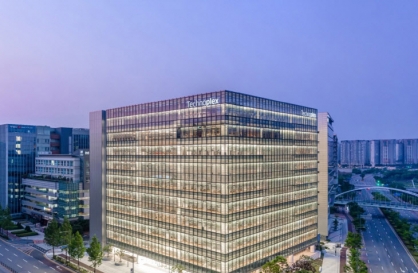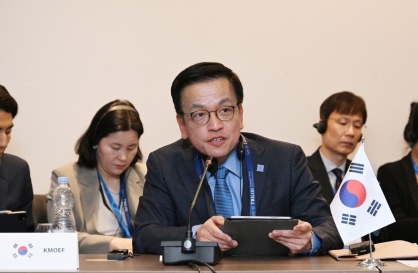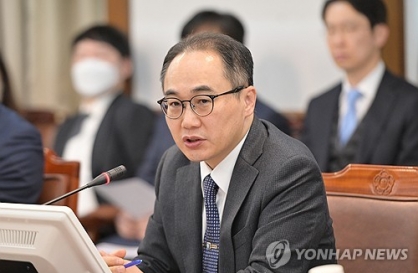South Korea’s Defense Ministry said Wednesday that the U.S. Terminal High Altitude Area Defense system will be deployed in Seongju, North Gyeongsang Province.

“The joint working group for THAAD from South Korea and the U.S. has recommended the Seongju area as the optimal place for THAAD, based on the belief that it maximizes military efficacy and guarantees safety of the locals, while having no negative repercussions on health (of the citizens) and the environment. The defense ministers (secretaries) of both countries have approved it,” Deputy Minister of Defense Yoo Jeh-seung said during a media briefing.
South Korea and the U.S. announced Friday that they had decided to station the weapon system here from 2017, to protect the country from North Korea’s nuclear and missile threats.
The allies have been carrying out talks on deploying the advanced missile defense system here, after North Korea conducted a nuclear test and a long-range rocket launch earlier in the year.
The North has been increasing its efforts to acquire the capacity to fire nuclear-armed ballistic missiles under orders from its leader Kim Jong-un.
“By operating THAAD in Seongju, (the military) can protect the safety of Korean citizens in half to two-thirds of our territory from the North’s nuclear and missile threats. We can also drastically enhance our capacity to guard the military capacity of the South Korea-U.S. alliance and key facilities like nuclear reactor and fuel storage capacities,” Yoo said.
Wednesday’s announcement had been expected to come next week, but the ministry had brought it forward after local media reported Tuesday that the allies had decided on Seongsan-ri, Seongju.
South Korea and the U.S. announced Friday that they had decided to station the weapon system here from 2017, to protect the country from North Korea’s nuclear and missile threats.
The allies have been carrying out talks on deploying the advanced missile defense system here, after North Korea conducted a nuclear test and a long-range rocket launch earlier in the year.
The North has been increasing its efforts to acquire the capacity to fire nuclear-armed ballistic missiles under orders from its leader Kim Jong-un.
“By operating THAAD in Seongju, (the military) can protect the safety of Korean citizens in half to two-thirds of our territory from the North’s nuclear and missile threats. We can also drastically enhance our capacity to guard the military capacity of the South Korea-U.S. alliance and key facilities like nuclear reactor and fuel storage capacities,” Yoo said.
Wednesday’s announcement had been expected to come next week, but the ministry had brought it forward after local media reported Tuesday that the allies had decided on Seongsan-ri, Seongju.

THAAD, first deployed in Guam in 2013 and operated by the U.S. military, can intercept short, medium and intermediate-range ballistic missiles at ranges of 200 kilometers and at altitudes up to 150 kilometers. According to its producer Lockheed Martin, it has 100 percent mission success rate in 13 consecutive flight tests since 2005.
By stationing the system in Seongju, the allies could theoretically cover South Korea’s southern territories along with U.S. bases in Gyeonggi Province.
The range would not extend to Seoul, where some 10 million people live, along with key facilities such as Cheong Wa Dae, the National Assembly and several ministries including the Ministry of Defense.
The U.S. forces based in Yongsan, Seoul, are slated to move to Pyeongtaek, Gyeonggi Province, by next year, which would put it within the range of the Seongju-based THAAD system.
Amid inter-Korea tension, North Korea has been stepping up on its belligerent rhetoric against the South, going as far as to conduct an attack exercise on a model of the presidential office in Seoul.
The North also recently revealed its long-range multiple rocket launchers, presumed to be capable of striking targets located as far as 200 kilometers away, Such actions have added pressure on defending the capital region, which is less than 200 kilometers away from the primary launching spot for the North’s short-ranged Scud missiles.
“If we were to operate THAAD to protect the capital region, the operating potential of it would be restrained,” Yoo said, admitting that the Seongju THAAD battery would not be able to cover the most highly populated area in the country.
He said THAAD would be able protect over 20 million people by being stationed in Seongju.
To protect Seoul and Gyeonggi Province, the military plans to use the current PAC-2 missiles, and subsequently deploy the upgraded PAC-3 missiles.
“The biggest threat to the capital region are the Scud missiles, located around 100-200 kilometers from Seoul. If fired from here, the altitude would be relatively low (under 20 kilometers), which would make the patriot missiles better option against Scuds than THAAD,” he said.
The current PAC-2 missiles are known to be more adequate in shooting down enemy fighter jets than ballistic missiles, and PAC-3 are expected to be deployed by 2018.
Yoo also admitted there would be limitations to defending against shorter-range missiles shot at a “lofted” trajectory -- which would travel at a higher altitude than conventional ones -- saying that “no weapon system is capable of covering all areas of defense.”
THAAD’s deployment has come with opposition from within and beyond the peninsula.
China and Russia have feverishly opposed the deployment, and some observers have pointed to the geopolitical risks of deploying a high-powered U.S. weapon system so close to two of the largest powers in the region.
One of the benefits of Seongju is thought to be its location, which is one of the farthest regions from China.
County executives and residents of Seongju visited the Defense Ministry on Wednesday to protest Seoul and Washington’s decision.
Vice Defense Minister Hwang In-moo was slated to visit the Seongju area to offer explanations related to the THAAD deployment, but was forced to turn back after the country residents insisted on visiting the ministry.
Confusion had also surfaced in relation to the 3 p.m. media briefing, as the Defense Ministry said at around 2:50 p.m. that it was cancelling the briefing but flip-flopped just five minutes later. Officials explained that the confusion was due to some officials wanting to talk to Seongju residents before addressing the press. The U.S. side was not present at the briefing due to time constraints, according to the ministry officials.
By Yoon Min-sik(minsikyoon@heraldcorp.com)
By stationing the system in Seongju, the allies could theoretically cover South Korea’s southern territories along with U.S. bases in Gyeonggi Province.
The range would not extend to Seoul, where some 10 million people live, along with key facilities such as Cheong Wa Dae, the National Assembly and several ministries including the Ministry of Defense.
The U.S. forces based in Yongsan, Seoul, are slated to move to Pyeongtaek, Gyeonggi Province, by next year, which would put it within the range of the Seongju-based THAAD system.
Amid inter-Korea tension, North Korea has been stepping up on its belligerent rhetoric against the South, going as far as to conduct an attack exercise on a model of the presidential office in Seoul.
The North also recently revealed its long-range multiple rocket launchers, presumed to be capable of striking targets located as far as 200 kilometers away, Such actions have added pressure on defending the capital region, which is less than 200 kilometers away from the primary launching spot for the North’s short-ranged Scud missiles.
“If we were to operate THAAD to protect the capital region, the operating potential of it would be restrained,” Yoo said, admitting that the Seongju THAAD battery would not be able to cover the most highly populated area in the country.
He said THAAD would be able protect over 20 million people by being stationed in Seongju.
To protect Seoul and Gyeonggi Province, the military plans to use the current PAC-2 missiles, and subsequently deploy the upgraded PAC-3 missiles.
“The biggest threat to the capital region are the Scud missiles, located around 100-200 kilometers from Seoul. If fired from here, the altitude would be relatively low (under 20 kilometers), which would make the patriot missiles better option against Scuds than THAAD,” he said.
The current PAC-2 missiles are known to be more adequate in shooting down enemy fighter jets than ballistic missiles, and PAC-3 are expected to be deployed by 2018.
Yoo also admitted there would be limitations to defending against shorter-range missiles shot at a “lofted” trajectory -- which would travel at a higher altitude than conventional ones -- saying that “no weapon system is capable of covering all areas of defense.”
THAAD’s deployment has come with opposition from within and beyond the peninsula.
China and Russia have feverishly opposed the deployment, and some observers have pointed to the geopolitical risks of deploying a high-powered U.S. weapon system so close to two of the largest powers in the region.
One of the benefits of Seongju is thought to be its location, which is one of the farthest regions from China.
County executives and residents of Seongju visited the Defense Ministry on Wednesday to protest Seoul and Washington’s decision.
Vice Defense Minister Hwang In-moo was slated to visit the Seongju area to offer explanations related to the THAAD deployment, but was forced to turn back after the country residents insisted on visiting the ministry.
Confusion had also surfaced in relation to the 3 p.m. media briefing, as the Defense Ministry said at around 2:50 p.m. that it was cancelling the briefing but flip-flopped just five minutes later. Officials explained that the confusion was due to some officials wanting to talk to Seongju residents before addressing the press. The U.S. side was not present at the briefing due to time constraints, according to the ministry officials.
By Yoon Min-sik(minsikyoon@heraldcorp.com)





![[Weekender] Korean psyche untangled: Musok](http://res.heraldm.com/phpwas/restmb_idxmake.php?idx=644&simg=/content/image/2024/05/02/20240502050841_0.jpg&u=)

![[Eye Interview] 'If you live to 100, you might as well be happy,' says 88-year-old bestselling essayist](http://res.heraldm.com/phpwas/restmb_idxmake.php?idx=644&simg=/content/image/2024/05/03/20240503050674_0.jpg&u=)










![[Herald Interview] Director of 'Goodbye Earth' aimed to ask how we would face apocalypse](http://res.heraldm.com/phpwas/restmb_idxmake.php?idx=652&simg=/content/image/2024/05/03/20240503050732_0.jpg&u=)
